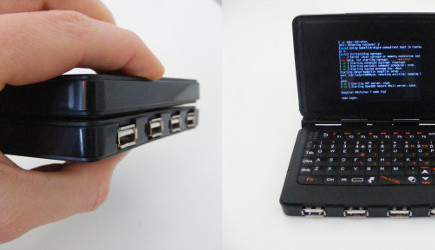RasPi Hacks: Build Your Own Mobile Linux Terminal
January 16, 2015
on
on

Using off-the-shelf parts Chris Robinson build himself a pocket-sized clamshell device powered by a Raspberry Pi and provided a How-To. Warning! Involves serious Pi mutilation.
I'm no fan of the tablet. With its tap tap pray interface it locks the user out of any significant interaction with the device. Control reduced to the few settings remaining after the programmers and the designers battled it out, the tablet is good for little more than passive information consumption. Even something as established as email can't be done right anymore. Most mails signed with some version of 'sent from a mobile device', a coded apology for brevity and odd typos. And that's just handling information with the device, I'm not even gonna go into controlling the actual device itself.
Which is why I am particularly enamored by Robinson's handheld Linux terminal. It is portable but has a physical keyboard. In the How-To published on n-o-d-e.net he writes: “It’s basically a full handheld linux system that can do almost everything a normal sized computer can do. It’s not going to destroy any benchmark tests, so it’s best suited to command line stuff.”
To make the terminal as small as possible Robinson stripped the Pi to its bare necessities. Using a hacksaw blade and wire cutters he removed the GPIO pins and the HDMI, USB & audio ports.
For a screen, Robinson used the Adafruit PiTFT - 2.8” Touchscreen which he attached to the stripped-down Raspberry Pi. Together they are only roughly 1 cm thick and fit in the upper of the two hingedly connected cases. The lower case houses the physical keyboard and four USB ports. To see how its done and for some nice pictures of the process, head over to the How-To page on n-o-d-e.net (and check out the rest of the site as well, much more nice stuff).
Robinson says he wants to use the experience he gained building the Linux terminal to create affordable open source hardware. Which is great! But than he specifies: “perhaps a mini tablet or something”...
Today I learned love for open technology does not necessarily result in tablet-hate.
I'm no fan of the tablet. With its tap tap pray interface it locks the user out of any significant interaction with the device. Control reduced to the few settings remaining after the programmers and the designers battled it out, the tablet is good for little more than passive information consumption. Even something as established as email can't be done right anymore. Most mails signed with some version of 'sent from a mobile device', a coded apology for brevity and odd typos. And that's just handling information with the device, I'm not even gonna go into controlling the actual device itself.
Which is why I am particularly enamored by Robinson's handheld Linux terminal. It is portable but has a physical keyboard. In the How-To published on n-o-d-e.net he writes: “It’s basically a full handheld linux system that can do almost everything a normal sized computer can do. It’s not going to destroy any benchmark tests, so it’s best suited to command line stuff.”
To make the terminal as small as possible Robinson stripped the Pi to its bare necessities. Using a hacksaw blade and wire cutters he removed the GPIO pins and the HDMI, USB & audio ports.
For a screen, Robinson used the Adafruit PiTFT - 2.8” Touchscreen which he attached to the stripped-down Raspberry Pi. Together they are only roughly 1 cm thick and fit in the upper of the two hingedly connected cases. The lower case houses the physical keyboard and four USB ports. To see how its done and for some nice pictures of the process, head over to the How-To page on n-o-d-e.net (and check out the rest of the site as well, much more nice stuff).
Robinson says he wants to use the experience he gained building the Linux terminal to create affordable open source hardware. Which is great! But than he specifies: “perhaps a mini tablet or something”...
Today I learned love for open technology does not necessarily result in tablet-hate.
Read full article
Hide full article


Discussion (0 comments)